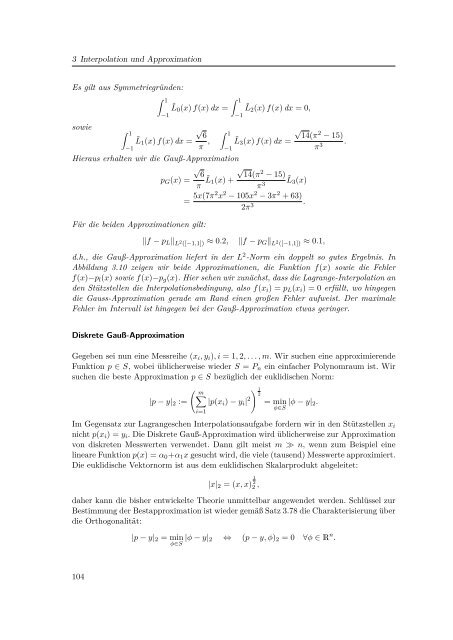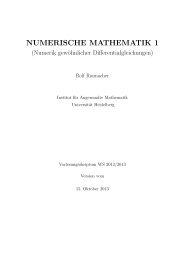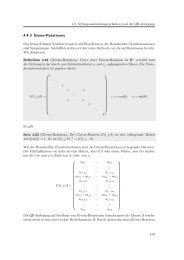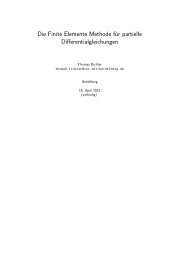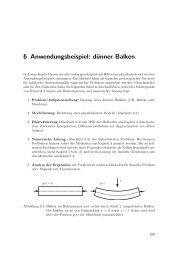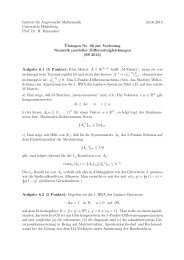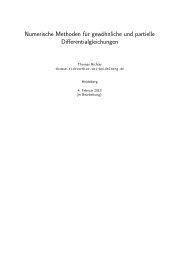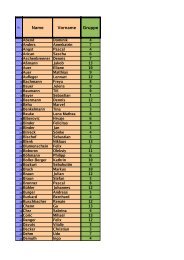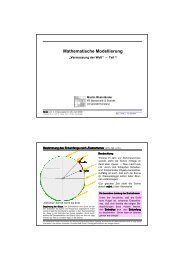Einführung in die Numerische Mathematik - Lehrstuhl Numerische ...
Einführung in die Numerische Mathematik - Lehrstuhl Numerische ...
Einführung in die Numerische Mathematik - Lehrstuhl Numerische ...
Sie wollen auch ein ePaper? Erhöhen Sie die Reichweite Ihrer Titel.
YUMPU macht aus Druck-PDFs automatisch weboptimierte ePaper, die Google liebt.
3 Interpolation und Approximation<br />
Es gilt aus Symmetriegründen:<br />
∫ 1<br />
−1<br />
˜L 0 (x) f(x) dx =<br />
∫ 1<br />
−1<br />
˜L 2 (x) f(x) dx = 0,<br />
sowie<br />
∫ √ 1<br />
∫ √<br />
6<br />
1<br />
14(π<br />
˜L 1 (x) f(x) dx =<br />
−1<br />
π , ˜L 2 − 15)<br />
3 (x) f(x) dx =<br />
−1<br />
π 3 .<br />
Hieraus erhalten wir <strong>die</strong> Gauß-Approximation<br />
√ √<br />
6<br />
p G (x) =<br />
π ˜L 14(π 2 − 15)<br />
1 (x) +<br />
π 3<br />
˜L3 (x)<br />
Für <strong>die</strong> beiden Approximationen gilt:<br />
= 5x(7π2 x 2 − 105x 2 − 3π 2 + 63)<br />
2π 3 .<br />
‖f − p L ‖ L 2 ([−1,1]) ≈ 0.2, ‖f − p G ‖ L 2 ([−1,1]) ≈ 0.1,<br />
d.h., <strong>die</strong> Gauß-Approximation liefert <strong>in</strong> der L 2 -Norm e<strong>in</strong> doppelt so gutes Ergebnis. In<br />
Abbildung 3.10 zeigen wir beide Approximationen, <strong>die</strong> Funktion f(x) sowie <strong>die</strong> Fehler<br />
f(x)−p l (x) sowie f(x)−p g (x). Hier sehen wir zunächst, dass <strong>die</strong> Lagrange-Interpolation an<br />
den Stützstellen <strong>die</strong> Interpolationsbed<strong>in</strong>gung, also f(x i ) = p L (x i ) = 0 erfüllt, wo h<strong>in</strong>gegen<br />
<strong>die</strong> Gauss-Approximation gerade am Rand e<strong>in</strong>en großen Fehler aufweist. Der maximale<br />
Fehler im Intervall ist h<strong>in</strong>gegen bei der Gauß-Approximation etwas ger<strong>in</strong>ger.<br />
Diskrete Gauß-Approximation<br />
Gegeben sei nun e<strong>in</strong>e Messreihe (x i , y i ), i = 1, 2, . . . , m. Wir suchen e<strong>in</strong>e approximierende<br />
Funktion p ∈ S, wobei üblicherweise wieder S = P n e<strong>in</strong> e<strong>in</strong>facher Polynomraum ist. Wir<br />
suchen <strong>die</strong> beste Approximation p ∈ S bezüglich der euklidischen Norm:<br />
( m<br />
) 1<br />
∑<br />
|p − y| 2 := |p(x i ) − y i | 2 2<br />
i=1<br />
= m<strong>in</strong><br />
φ∈S |φ − y| 2.<br />
Im Gegensatz zur Lagrangeschen Interpolationsaufgabe fordern wir <strong>in</strong> den Stützstellen x i<br />
nicht p(x i ) = y i . Die Diskrete Gauß-Approximation wird üblicherweise zur Approximation<br />
von diskreten Messwerten verwendet. Dann gilt meist m ≫ n, wenn zum Beispiel e<strong>in</strong>e<br />
l<strong>in</strong>eare Funktion p(x) = α 0 +α 1 x gesucht wird, <strong>die</strong> viele (tausend) Messwerte approximiert.<br />
Die euklidische Vektornorm ist aus dem euklidischen Skalarprodukt abgeleitet:<br />
|x| 2 = (x, x) 1 2<br />
2 ,<br />
daher kann <strong>die</strong> bisher entwickelte Theorie unmittelbar angewendet werden. Schlüssel zur<br />
Bestimmung der Bestapproximation ist wieder gemäß Satz 3.78 <strong>die</strong> Charakterisierung über<br />
<strong>die</strong> Orthogonalität:<br />
|p − y| 2 = m<strong>in</strong><br />
φ∈S |φ − y| 2 ⇔ (p − y, φ) 2 = 0 ∀φ ∈ R n .<br />
104


